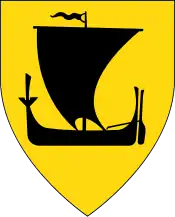Mo i Rana
Mo | |
|---|---|
 View of the town from the fjord in July 2003 | |
 Mo i Rana Location of the city  Mo i Rana Mo i Rana (Norway) | |
| Coordinates: 66°18′46″N 14°08′34″E / 66.3128°N 14.1428°E | |
| Country | Norway |
| Region | Northern Norway |
| County | Nordland |
| District | Helgeland |
| Municipality | Rana Municipality |
| Established as | |
| Ladested | 1923–1964 |
| Town (By) | 1997 |
| Area | |
| • Total | 12.03 km2 (4.64 sq mi) |
| Elevation | 26 m (85 ft) |
| Population (2023)[2] | |
| • Total | 25,980 |
| • Density | 1,568/km2 (4,060/sq mi) |
| Demonym | Moværing |
| Time zone | UTC+01:00 (CET) |
| • Summer (DST) | UTC+02:00 (CEST) |
| Post Code | 8622 Mo i Rana |
| Mo ladested | |
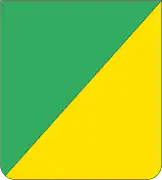 Coat of arms | |
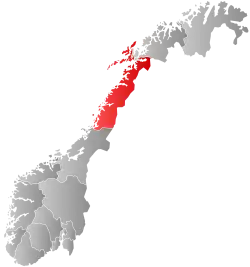 Nordland within Norway | |
| Country | Norway |
| County | Nordland |
| District | Helgeland |
| Established | 1 Jan 1923 |
| • Preceded by | Mo herred |
| Disestablished | 1 Jan 1964 |
| • Succeeded by | Rana Municipality |
| Administrative centre | Mo i Rana |
| Area (upon dissolution) | |
| • Total | 12 km2 (5 sq mi) |
| Population (1964) | |
| • Total | 9,616 |
| • Density | 800/km2 (2,100/sq mi) |
| ISO 3166 code | NO-1803[4] |
Mo i Rana (Norwegian pronunciation: [ˈmuː ɪ ˈrɑ̀ːnɑ]) is a city, and the administrative centre of the municipality of Rana, in Nordland county, Norway. It is located in the Helgeland region of Nordland, just south of the Arctic Circle. Some of the city's suburbs include Båsmoen and Ytteren in the north, Gruben in the south east, Selfors in the east, and Åga/Hauknes/Dalsgrenda in the south.
The name "Mo i Rana" (English: Mo in Rana) distinguish it from other places named Mo (including the town of Mosjøen, also located in Helgeland). The city's postal address was "Mo 8600" until 1999, when it was changed to "Mo i Rana 8600". Today, the postal address is "8622 Mo i Rana".
The 12.03-square-kilometre (2,970-acre) city has a population (2018) of 18,866 and a population density of 1,568 inhabitants per square kilometre (4,060/sq mi).[2] This makes it the largest city in Helgeland, and the second largest city (after Bodø) in Nordland county.
Name
Directly translated, the name Mo i Rana means "Mo in Rana". The town (originally the parish) is named after the old Mo farm (Old Norse: Móar) since the first Mo Church was built there and this is the site of the modern town of Mo. The name is derived from the word móar which is the plural form of mór which means "moorland". The last element is the name of the large Rana Municipality (Old Norse: Rana) which means "quick" or "fast", likely referring to the fast water flow in the Ranfjorden which flows past the town. Originally the village (and later the growing town) was generally known simply as Mo, but since many Norwegian settlements bear that name, disambiguating it by specifying it as the one that is located in Rana became commonplace. As the town grew and became more well-known nationwide, the longer form came to dominate. Locals may still refer to it simply as Mo. Also, the short name Mo may also be used as shorthand in contexts in which it is already established that one is referring to Mo i Rana.[5]
Education
In Mo i Rana, Nord University is located at Campus Helgeland just a short distance from shops, cafes and bars, cinema, theater, training facilities, and transport services including an airport. The campus hosts around 470 students from Nord University and 330 students from partner institutions. Campus Helgeland was opened in 2013 and is one of Norway's newest campuses.[6]
Studentorganisasjonen Helgeland (SOH) is the student association at Nord University, Campus Helgeland. The organization was formed on 14 April 2013, and was previously known as Rana Studentforening, but this was changed when the organization became part of the regional mother-organization Studentorganisasjonen Nord in 2020.
History

Mining, building boats (Nordlands boats), and hunting/fishing used to be the main ways of life in Rana. Starting in the summer of 1730, there was a Sámi market in Mo. The market was held on the main church grounds until 1810. In 1860, wholesale merchant L.A. Meyer started a trade center, licensed by royal authority. Meyer traded flour, herring and tobacco, reindeer meat, skins and venison with the Swedes. The trade with Sweden increased especially during Sweden's difficult economic years from 1892 to the start of the First World War. Many paths now used as hiking trails were originally trade paths for mountain dwellers from Sweden to Mo i Rana. One example is a path that starts in the Vindelfjällens Nature Reserve at Ammarnäs and follows the Vindel River valley, then joins Vindelkroken and eventually crosses the Norwegian border to Mo i Rana.
The municipality is rich on iron ores and water to produce power. This was very important for industrial development. The Dunderland Iron Ore Company (1902–1947) established the first mines in Storforshei (27 kilometres or 17 miles north of Mo i Rana). The mining company Rana Gruber was also established in 1937, and in 1946, the Norwegian Parliament approved plans for the construction of an Iron mill in Norway. A/S Norwegian Iron Work Company was established.
In 1955, the first steel was produced for Norway and other countries. The construction of the iron works took nine years.
During this period the village of Mo i Rana became an industrial city. People from all over Norway moved to Mo i Rana for work. The community needed homes for thousands of new residents and, the construction of houses and residential blocks started immediately. Infrastructure such as electricity and water were established for the city. In 1930, the population was only 1300 people, but had increased to 7,000 by 1955. In 1978 The Iron Mill employed approximately 4,500 of the municipality's 25,000 inhabitants.[7]
The Norwegian Parliament resolved in June 1988 to phase out state ownership of the company. Today there are 119 industrial companies located at the industrial estate (Mo Industrial Park). The companies mainly support the iron and steel industry, the engineering industry, the research and development service industry and the information technology industry. In total, the companies employ approximately 1900 people.
From the end of the Second World War until the early 1990s, Mo i Rana, with the town's steel mill as its cornerstone, was dependent upon heavy industry. Following the decline of heavy industry, new service industries have now grown in the town.
"Graveyard War" in 1951
During the autumn of 1951, around "700 or 800" protesters showed up at the local graveyard as a result of a "night-time mobilisation"[8] to oppose the government's attempt to remove Soviet corpses from graves. Some 93,000 Soviet prisoners-of-war had been brought to Norway between 1941 and 1945 by the Germans to work on improvements to infrastructure in Norway. A 2013 article in Dagbladet noted that "the protests were so powerful that [then minister of defence] Jens Chr. Hauge personally stopped the [government's] action".[8]
It was only in this locality the government's Operation Asphalt stopped by civilians. More than 8000 Soviet corpses were removed from other graveyards in Northern Norway although the government had not decided the location of a new graveyard for these corpses.[8] The protests in Mo i Rana were not mentioned in national media during the Cold War.
Municipal self-governance (1923–1964)
Rana Municipality was established on 1 January 1838, under the old formannskapsdistrikt law. Shortly afterwards, in 1839, the municipality was divided into Nord-Ranen and Sør-Ranen.[9] In 1844, Nord-Ranen was renamed Mo herred. On 1 January 1923, the village of Mo was designated as a ladested and so it was separated from the rest of the municipality to become a municipality of its own. The new town of Mo (population: 1,305) kept the name Mo and the rest of the old municipality became known as Nord-Rana (bringing back the old name for the area).
During the 1960s, there were many municipal mergers across Norway due to the work of the Schei Committee. On 1 January 1964, the municipality of Nord-Rana (population: 11,636) was merged with the town of Mo i Rana (population: 9,616), the part of the municipality of Sør-Rana located north of the Ranfjorden (population: 697), and the Sjona area of Nesna Municipality (population: 543) to create the large, new Rana Municipality.[10]
Mo was a self-governing municipality from 1923 until 1964. During that time, this municipality was responsible for primary education (through 10th grade), outpatient health services, senior citizen services, unemployment, social services, zoning, economic development, and municipal roads. During its existence, this municipality was governed by a municipal council of elected representatives, which in turn elected a mayor.[11]
Municipal council
The municipal council (Bystyre) of Mo was made up of representatives that were elected to four year terms. The party breakdown of the final municipal council was as follows:
| Party name (in Norwegian) | Number of representatives | |
|---|---|---|
| Labour Party (Arbeiderpartiet) | 18 | |
| Conservative Party (Høyre) | 4 | |
| Communist Party (Kommunistiske Parti) | 4 | |
| Christian Democratic Party (Kristelig Folkeparti) | 1 | |
| Liberal Party (Venstre) | 2 | |
| Total number of members: | 29 | |
| Party name (in Norwegian) | Number of representatives | |
|---|---|---|
| Labour Party (Arbeiderpartiet) | 15 | |
| Conservative Party (Høyre) | 4 | |
| Communist Party (Kommunistiske Parti) | 6 | |
| Liberal Party (Venstre) | 3 | |
| Local List(s) (Lokale lister) | 1 | |
| Total number of members: | 29 | |
| Party name (in Norwegian) | Number of representatives | |
|---|---|---|
| Labour Party (Arbeiderpartiet) | 15 | |
| Conservative Party (Høyre) | 3 | |
| Communist Party (Kommunistiske Parti) | 6 | |
| Liberal Party (Venstre) | 3 | |
| Local List(s) (Lokale lister) | 1 | |
| Total number of members: | 28 | |
| Party name (in Norwegian) | Number of representatives | |
|---|---|---|
| Labour Party (Arbeiderpartiet) | 9 | |
| Conservative Party (Høyre) | 3 | |
| Communist Party (Kommunistiske Parti) | 6 | |
| Liberal Party (Venstre) | 2 | |
| Total number of members: | 20 | |
| Party name (in Norwegian) | Number of representatives | |
|---|---|---|
| Labour Party (Arbeiderpartiet) | 7 | |
| Communist Party (Kommunistiske Parti) | 7 | |
| Joint List(s) of Non-Socialist Parties (Borgerlige Felleslister) | 3 | |
| Local List(s) (Lokale lister) | 3 | |
| Total number of members: | 20 | |
| Party name (in Norwegian) | Number of representatives | |
|---|---|---|
| Labour Party (Arbeiderpartiet) | 11 | |
| Joint List(s) of Non-Socialist Parties (Borgerlige Felleslister) | 8 | |
| Local List(s) (Lokale lister) | 1 | |
| Total number of members: | 20 | |
| Note: Due to the German occupation of Norway during World War II, no elections were held for new municipal councils until after the war ended in 1945. | ||
| Party name (in Norwegian) | Number of representatives | |
|---|---|---|
| Labour Party (Arbeiderpartiet) | 9 | |
| Communist Party (Kommunistiske Parti) | 1 | |
| Liberal Party (Venstre) | 3 | |
| Local List(s) (Lokale lister) | 1 | |
| Non-Socialist Group (Borgerlig Samling) | 6 | |
| Total number of members: | 20 | |
Mayors
The mayors of Mo i Rana municipality:[19][20]
- 1923-1923: Einar Nilsen
- 1924-1924: C. N. Jacobsen
- 1925-1925: Einar Nilsen
- 1926–1929: Kristian P. Evjen
- 1930–1931: Alf Ljones
- 1931–1932: Carsten Venes
- 1932–1935: Per Kristian Rygh
- 1936–1937: Anton Getz
- 1937–1940: Alf Ljones
- 1945–1947: Sigurd Marsten
- 1947–1948: Alf Ljones
- 1948–1955: Erling Lange
- 1956–1963: Eilif Granhaug (Ap)
Industry

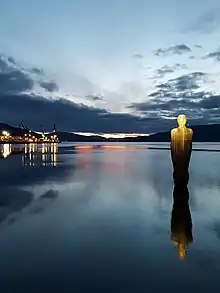
Mo Industrial Park is one of Norway's largest industrial parks. It is important for the local society, giving work to approximately 1900 people. As of 2023, FREYR has a so-called[21] test factory for battery technology; the size of the factory is 13,000 square meters.[22] The company said that it will be minimizing[21] investments in 2024.
The National Library of Norway has a division in Mo i Rana. HelgelandsKraft supplies electric power to the Helgeland region. NRK (Norwegian Broadcasting Corporation) has a division in Mo i Rana. Rana Blad and Rana No Are the towns local newspapers. Radio 3 Rana is the local radio station.
Norsk Jernverk, established in 1946, produced steel for the country until 1988, when it was divided into several new companies. The iron mill had a significant impact on the town development.
In 1978, the city's population had grown from approximately 2000 to 25,000.
Transport
Mo i Rana has a regional airport, Mo i Rana Airport, Røssvoll, situated 10 kilometres (6.2 mi) north of the city in Røssvoll. The airport is a part of the Norwegian STOLport network. Mo i Rana is connected to the Nordland Line railway. This is a railway line between Trondheim and Bodø. The main north–south road in Norway, European route E6, passes through the city. The European route E12 begins in Mo i Rana and connect the city to Sweden and Finland. A bus network runs throughout most of the city and its suburbs.
An international tourist route Blue Highway (in Norwegian: Blå vegen) begins in Mo i Rana. The route goes via Sweden and Finland to Russia.
Culture
Havmann (English: The Man from the Sea) is a sculpture made from Arctic granite located in the Ranfjord. It was made in 1995 by the English sculptor Antony Gormley. It is a part of Artscape Nordland, which can be seen from the city centre. The festival Havmanndagene is held in the town every year in May. Nordland Theater is a regional theater that tours in Nordland. It was established in 1979, and is situated in a new theater building with three stages.
Rana Museum, department of Helgeland Museum, is located in the new museum building "MOment" (2020), situated by the fjord. The museum has a special focus on industrial history, and the main exhibition shows everything from large machines to listening stations with films from old Rana. The industrial adventure and the development that happened also changed the fashion and peoples homes, also showcased through interiors and clothes from the 1960s and 70s.[23]
The county library of Nordland is situated in Mo i Rana. Arctic Circle Raceway is a motorsports and road racing track, situated 30 kilometres (19 mi) north of Mo i Rana.
Churches
Mo Church is the oldest building in Mo i Rana. Built in 1724, it is made of wood and has 400 seats. The church was built on the initiative of Thomas von Westen, a Norwegian priest and missionary who worked among the Sami. Numerous victims of World War II are buried in the graveyard, which receives visitors from the entire world in search of relatives. Gruben Church is another church in Mo i Rana. It was built in 1965 to serve the growing town. In 1977, Ytteren Church was also built.
 Mo Church
Mo Church Gruben Church
Gruben Church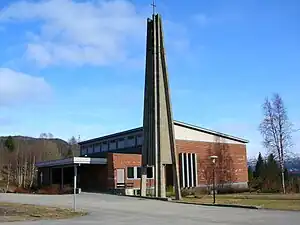 Ytteren Church
Ytteren Church
Geography
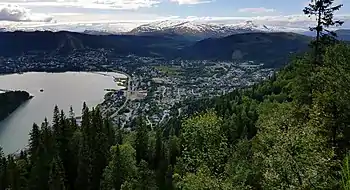
Mo i Rana is located at the head of Ranfjorden, just on the southern side of the Saltfjellet mountains with the Svartisen glacier, Norway's second largest. The river Ranelva meets the Ranfjorden in Mo i Rana. Rana and Saltfjellet are famous for their numerous caves. Two of the caves are open to the public, Grønligrotta and Setergrotta. Mo i Rana is situated about 80 kilometres (50 mi) south of the Arctic Circle.
Climate
Mo i Rana's climate is usually classified as subarctic (Köppen Dfc bordering on Dsc),[24] with long, cold winters, and short, warm summers. Mo I Rana is situated about 70 kilometres (43 mi) from the coast line, giving it colder winters than towns at the coast. There is much precipitation due to the mountains north and east of town, often with much snow in winter. Blizzards in winter can go on for hours, potentially creating traffic difficulties and cancelling flights. Because of Mo i Rana's latitude, summer days are very long and winter days are very short on daylight. In the winter season, the Northern Lights can be seen on the night sky. It varies in intensity, coloured from white green to deep red, and comes in different shapes, such as beams, arches and draperies.

July and August are the warmest months; July mean is 14.9 °C (58.8 °F) and average daily high 19 °C (66 °F) (1991–2020).[25] There are usually two to three warm periods during the summer, when the average temperature is between 20 and 28 °C (68 and 82 °F) at daytime. The warm days may last for 2–14 days, with the temperature peaking at 31 °C (88 °F). On rare occasions, the overnight low does not go below 20 °C (68 °F), known in Norway as tropical night (tropenatt Norwegian).
Autumn begins in September. The trees lose their leaves in October, and the flowers disappear. During November, fresh water and rivers start to freeze, and the landscape is covered with snow. Only the spruce forest stays green throughout the winter. In the winter, the sun is low on the horizon, and is only visible for a few hours. Heating through sunlight is limited because of Mo i Rana's high-latitude location. Mountains block the sunlight when the sun is low on the horizon, which means that the sun is not visible at all during the month of December. There are normally two to three very cold periods in the winter with temperature dipping close to minus 30 °C (86 °F). The cold periods normally last 3–7 days. The wettest period is autumn and winter, while spring and summer is the driest. The airport is situated in a valley 8 km away from the fjord, so the airport has colder lows than the town itself. The all-time high temperature is 33.0 °C (91.4 °F) recorded 27 July 2019 (beating 32.6 °C (90.7 °F) from July 2018); the all-time low at the airport is −35.2 °C (−31.4 °F) recorded 7 January 2010 (record low for Dec from 2010).
| Climate data for Mo i Rana 1991–2020, extremes 1935–present[lower-alpha 1] | |||||||||||||
|---|---|---|---|---|---|---|---|---|---|---|---|---|---|
| Month | Jan | Feb | Mar | Apr | May | Jun | Jul | Aug | Sep | Oct | Nov | Dec | Year |
| Record high °C (°F) | 8.0 (46.4) |
9.2 (48.6) |
12.4 (54.3) |
18.3 (64.9) |
28.3 (82.9) |
30.9 (87.6) |
33.0 (91.4) |
30.6 (87.1) |
24.6 (76.3) |
17.2 (63.0) |
12.0 (53.6) |
8.1 (46.6) |
33.0 (91.4) |
| Mean maximum °C (°F) | 5.3 (41.5) |
4.8 (40.6) |
7.2 (45.0) |
12.6 (54.7) |
20.5 (68.9) |
24.7 (76.5) |
28.1 (82.6) |
26.5 (79.7) |
20.2 (68.4) |
12.7 (54.9) |
8.5 (47.3) |
6.2 (43.2) |
28.9 (84.0) |
| Mean daily maximum °C (°F) | −3.7 (25.3) |
−2.9 (26.8) |
0.9 (33.6) |
6.0 (42.8) |
11.1 (52.0) |
15.4 (59.7) |
19.3 (66.7) |
18.0 (64.4) |
12.9 (55.2) |
6.1 (43.0) |
0.7 (33.3) |
−1.5 (29.3) |
6.9 (44.4) |
| Daily mean °C (°F) | −5.9 (21.4) |
−4.7 (23.5) |
−2.9 (26.8) |
2.0 (35.6) |
6.9 (44.4) |
11.1 (52.0) |
14.8 (58.6) |
13.7 (56.7) |
9.7 (49.5) |
3.5 (38.3) |
−0.7 (30.7) |
−3.3 (26.1) |
3.7 (38.7) |
| Mean daily minimum °C (°F) | −8.1 (17.4) |
−7.5 (18.5) |
−7.0 (19.4) |
−2.0 (28.4) |
2.6 (36.7) |
7.0 (44.6) |
10.2 (50.4) |
9.2 (48.6) |
6.1 (43.0) |
1.0 (33.8) |
−2.5 (27.5) |
−5.4 (22.3) |
0.3 (32.5) |
| Mean minimum °C (°F) | −24.4 (−11.9) |
−24.1 (−11.4) |
−19.8 (−3.6) |
−11.4 (11.5) |
−3.6 (25.5) |
0.3 (32.5) |
3.6 (38.5) |
2.0 (35.6) |
−1.6 (29.1) |
−8.7 (16.3) |
−14.0 (6.8) |
−19.0 (−2.2) |
−27.7 (−17.9) |
| Record low °C (°F) | −35.2 (−31.4) |
−30.7 (−23.3) |
−31.0 (−23.8) |
−17.2 (1.0) |
−8.0 (17.6) |
−2.2 (28.0) |
0.0 (32.0) |
−2.0 (28.4) |
−5.7 (21.7) |
−17.6 (0.3) |
−27.1 (−16.8) |
−29.8 (−21.6) |
−35.2 (−31.4) |
| Average precipitation mm (inches) | 146 (5.7) |
117 (4.6) |
112 (4.4) |
74 (2.9) |
64 (2.5) |
70 (2.8) |
97 (3.8) |
110 (4.3) |
155 (6.1) |
186 (7.3) |
136 (5.4) |
163 (6.4) |
1,430 (56.3) |
| Average relative humidity (%) | 80 | 80 | 76 | 74 | 69 | 68 | 71 | 76 | 82 | 83 | 85 | 83 | 77 |
| Average dew point °C (°F) | −9.5 (14.9) |
−9.3 (15.3) |
−6.4 (20.5) |
−2.6 (27.3) |
0.9 (33.6) |
5.1 (41.2) |
9.1 (48.4) |
8.7 (47.7) |
5.8 (42.4) |
0.5 (32.9) |
−3.5 (25.7) |
−6.0 (21.2) |
−0.6 (30.9) |
| Source 1: Norwegian Meteorological Institute[26][27][28][29][30] | |||||||||||||
| Source 2: Weather Online,[31] yr.no climate statistics Mo i Rana airport [25] | |||||||||||||
Note
- ↑ Humidity and dew point data for Mo i Rana comes from weather stations near Mo i Rana Airport (Altitude 70m, SN79600). Temperature data for Mo i Rana have been recorded since 1935. The weather station data used from July 1935 to 1941 came from Mo i Rana (SN79470), and the weather station data used from August 1946 to December 1956 came from Mo i Rana. i Rana II (SN79510), weather station data from January 1957 to September 1965 are from Mo i Rana III (SN79480), and temperature data from 2002 to the present are from Mo i Rana Airport. Precipitation data refer to data recorded at the Røssvoll weather station from 1961 to 1990.
International relations
Twin towns – Sister cities
Mo i Rana is twinned with:
 Fairbanks, Alaska, United States
Fairbanks, Alaska, United States Skellefteå, Västerbotten, Sweden
Skellefteå, Västerbotten, Sweden Aars, North Jutland, Denmark
Aars, North Jutland, Denmark
Notable people
See also
- Arctic Circle Raceway, local race track
- Blue Highway, tourist route
References
- ↑ In the Norwegian language, the word by can be translated as "town" or "city".
- 1 2 3 Statistisk sentralbyrå (1 January 2018). "Urban settlements. Population and area, by municipality".
- ↑ "Mo i Rana, Rana (Nordland)". yr.no. Retrieved 9 February 2019.
- ↑ Bolstad, Erik; Thorsnæs, Geir, eds. (26 January 2023). "Kommunenummer". Store norske leksikon (in Norwegian). Kunnskapsforlaget.
- ↑ Rygh, Oluf (1905). Norske gaardnavne: Nordlands amt (in Norwegian) (16 ed.). Kristiania, Norge: W. C. Fabritius & sønners bogtrikkeri. p. 143.
- ↑ "Nord University Mo i Rana". Nord university. Retrieved 16 July 2021.
- ↑ no:Norsk Jernverk
- 1 2 3 "60 års taushet og tristesse". Dagbladet. 4 July 2013.
- ↑ Thorsnæs, Geir, ed. (18 September 2016). "Nord-Rana". Store norske leksikon (in Norwegian). Kunnskapsforlaget. Retrieved 16 September 2018.
- ↑ Jukvam, Dag (1999). Historisk oversikt over endringer i kommune- og fylkesinndelingen (PDF) (in Norwegian). Statistisk sentralbyrå. ISBN 9788253746845.
- ↑ Hansen, Tore; Vabo, Signy Irene, eds. (20 September 2022). "kommunestyre". Store norske leksikon (in Norwegian). Kunnskapsforlaget. Retrieved 1 January 2023.
- ↑ "Kommunevalgene og Ordførervalgene 1959" (PDF) (in Norwegian). Oslo: Statistisk sentralbyrå. 1960. Retrieved 18 March 2020.
- ↑ "Kommunevalgene og Ordførervalgene 1955" (PDF) (in Norwegian). Oslo: Statistisk sentralbyrå. 1957. Retrieved 18 March 2020.
- ↑ "Kommunevalgene og Ordførervalgene 1951" (PDF) (in Norwegian). Oslo: Statistisk sentralbyrå. 1952. Retrieved 18 March 2020.
- ↑ "Kommunevalgene og Ordførervalgene 1947" (PDF) (in Norwegian). Oslo: Statistisk sentralbyrå. 1948. Retrieved 18 March 2020.
- ↑ "Kommunevalgene og Ordførervalgene 1945" (PDF) (in Norwegian). Oslo: Statistisk sentralbyrå. 1947. Retrieved 18 March 2020.
- ↑ "Kommunevalgene og Ordførervalgene 1937" (PDF) (in Norwegian). Oslo: Statistisk sentralbyrå. 1938. Retrieved 18 March 2020.
- ↑ "Kommunevalgene og Ordførervalgene 1934" (PDF) (in Norwegian). Oslo: Statistisk sentralbyrå. 1935. Retrieved 18 March 2020.
- ↑ Coldevin, Axel. Rana Bygdebok. Mo Prestegjeld etter 1850 (in Norwegian). Oslo: Mo Sparebank, Grøndahl & Søn Boktrykkeri.
- ↑ Alstadhaug, Leif (1986). "150 år med lokalt sjølstyre". Årbok for Rana 1986 (in Norwegian). Rana Blads trykkeri.
- 1 2 https://www.nrk.no/nordland/freyr-kutter-kraftig-i-batterisatsingen-i-mo-i-rana-1.16630920. NRK.no. Retrieved 2023-11-09
- ↑ https://www.nrk.no/nordland/freyr-gir-100-millioner-til-to-toppledere-_-apner-norges-forste-batterifabrikk-1.16355194. NRK.no. Retrieved 2023-11-09
- ↑ "Rana museum". Helgeland Museum (in Norwegian Bokmål). 24 February 2021. Retrieved 16 July 2021.
- ↑ "World map of Köppen-Geiger climate classification". Climate.gi.alaska.edu. University of Melbourne. Archived from the original on 25 March 2009. Retrieved 10 April 2009.
- 1 2 "Weather statistics for Mo i Rana LH as a table – Last 13 months".
- ↑ "Observations and weather statistics (SN79600 MO I RANA LUFTHAVN)". Norwegian Meteorological Institute. Retrieved 21 September 2023.
- ↑ "Temperaturnormaler per måned og år (Temperature norms per month and year)" (in Norwegian). Norwegian Meteorological Institute. Archived from the original on 9 October 2023. Retrieved 9 October 2023.
- ↑ "Nedbørnormaler per måned og år (Precipitation per month and year)" (in Norwegian). Norwegian Meteorological Institute. Archived from the original on 12 October 2023. Retrieved 12 October 2023.
- ↑ "Temperaturnormaler for stasjoner 1961–1990 (pdf)" (PDF) (in Norwegian). Norwegian Meteorological Institute. Archived from the original (PDF) on 29 October 2023. Retrieved 29 October 2023.
- ↑ "Nedbørnormaler for stasjoner 1961–1990 (pdf)" (PDF) (in Norwegian). Norwegian Meteorological Institute. Archived from the original (PDF) on 29 October 2023. Retrieved 29 October 2023.
- ↑ "Min. Temperature – Mo i Rana – Climate Robot Norway".
External links
- Rana municipality web pages
- Tourist information about the Arctic Circle area
- Image gallery of Mo i Rana
- moirana.com – local portal for Mo i Rana

